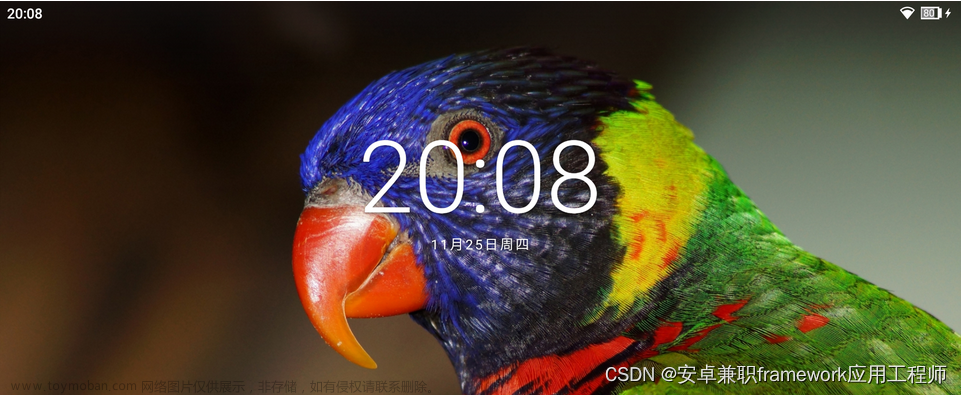1. 什么是System UI
SystemUI是Android系统级应用,负责反馈系统及应用状态并与用户保持大量的交互。业务主要涉及的组成部分包括状态栏(Status Bar),通知栏(Notification Panel),锁屏(Keyguard),控制中心(Quick Setting),音量调节(VolumeUI), 近期任务(Recents)等等。
图例如下所示:
![[Android14] SystemUI的启动,Android SystemUI,Android,SystemUI](https://imgs.yssmx.com/Uploads/2024/04/859549-1.png)
2. 源码位置
package name: com.android.systemui
SystemUI源码目录位于: framework/base/packages/SystemUI
Application位于: frameworks\base\packages\SystemUI\SystemUIApplication
Service位于: frameworks\base\services\java\com\android\server\
3. systemUI 启动流程
SystemServer.run()-> startOtherServices()-> startSystemUi()
SystemServer由ZygoteInit进程创建并启动
frameworks/base/services/java/com/android/server/SystemServer.java
/**
* The main entry point from zygote.
*/
public static void main(String[] args) {
new SystemServer().run();
}
private void run() {
......
// Start services.
try {
t.traceBegin("StartServices");
startBootstrapServices(t);
startCoreServices(t);
startOtherServices(t); //在这里会启动startSystemUi()
} catch (Throwable ex) {
Slog.e("System", "******************************************");
Slog.e("System", "************ Failure starting system services", ex);
throw ex;
} finally {
t.traceEnd(); // StartServices
}
......
}
/**
* Starts a miscellaneous grab bag of stuff that has yet to be refactored and organized.
*/
private void startOtherServices(@NonNull TimingsTraceAndSlog t) {
......
try {
startSystemUi(context, windowManagerF);
} catch (Throwable e) {
reportWtf("starting System UI", e);
}
......
}
private static void startSystemUi(Context context, WindowManagerService windowManager) {
PackageManagerInternal pm = LocalServices.getService(PackageManagerInternal.class);
Intent intent = new Intent();
intent.setComponent(pm.getSystemUiServiceComponent()); //这里
intent.addFlags(Intent.FLAG_DEBUG_TRIAGED_MISSING);
//Slog.d(TAG, "Starting service: " + intent);
context.startServiceAsUser(intent, UserHandle.SYSTEM);
windowManager.onSystemUiStarted();
}注意看这一段
intent.setComponent(pm.getSystemUiServiceComponent());
pm是PackageManagerInternal实例,它的getSystemUiServiceComponent()方法是一个抽象方法
frameworks/base/services/core/java/android/content/pm/PackageManagerInternal.java
/**
* @return The SystemUI service component name.
*/
public abstract ComponentName getSystemUiServiceComponent();PackageManagerService实现了该方法,如下:
frameworks/base/services/core/java/com/android/server/pm/PackageManagerService.java
@Override
public ComponentName getSystemUiServiceComponent() {
return ComponentName.unflattenFromString(mContext.getResources().getString(
com.android.internal.R.string.config_systemUIServiceComponent));
}com.android.internal.R.string.config_systemUIServiceComponent的值是
frameworks/base/core/res/res/values/config.xml
<!-- SystemUi service component -->
<string name="config_systemUIServiceComponent" translatable="false"
>com.android.systemui/com.android.systemui.SystemUIService</string>unflattenFromString返回的是ComponentName(“com.android.systemui”, “com.android.systemui.SystemUIService”);
unflattenFromString 具体方法如下,很简单,感兴趣的可以看看,不感兴趣的直接跳过就好,这个方法不是重点。
/**
* Recover a ComponentName from a String that was previously created with
* {@link #flattenToString()}. It splits the string at the first '/',
* taking the part before as the package name and the part after as the
* class name. As a special convenience (to use, for example, when
* parsing component names on the command line), if the '/' is immediately
* followed by a '.' then the final class name will be the concatenation
* of the package name with the string following the '/'. Thus
* "com.foo/.Blah" becomes package="com.foo" class="com.foo.Blah".
*
* @param str The String that was returned by flattenToString().
* @return Returns a new ComponentName containing the package and class
* names that were encoded in <var>str</var>
*
* @see #flattenToString()
*/
public static @Nullable ComponentName unflattenFromString(@NonNull String str) {
int sep = str.indexOf('/');
if (sep < 0 || (sep+1) >= str.length()) {
return null;
}
String pkg = str.substring(0, sep);
String cls = str.substring(sep+1);
if (cls.length() > 0 && cls.charAt(0) == '.') {
cls = pkg + cls;
}
return new ComponentName(pkg, cls);
}以上代码功能为通过Intent启动了SystemUIService。
于是走到SystemUIService的onCreate()方法
frameworks/base/packages/SystemUI/src/com/android/systemui/SystemUIService.java
public void onCreate() {
super.onCreate();
// Start all of SystemUI
((SystemUIApplication) getApplication()).startServicesIfNeeded();
......
}
public void startServicesIfNeeded() {
String[] names = SystemUIFactory.getInstance().getSystemUIServiceComponents(getResources());
startServicesIfNeeded(/* metricsPrefix= */ "StartServices", names);
}通过工厂模式获得SystemUI组件列表
frameworks/base/packages/SystemUI/src/com/android/systemui/SystemUIFactory.java
public String[] getSystemUIServiceComponents(Resources resources) {
return resources.getStringArray(R.array.config_systemUIServiceComponents);
}列表如下:
frameworks/base/packages/SystemUI/res/values/config.xml
<!-- SystemUI Services: The classes of the stuff to start. -->
<string-array name="config_systemUIServiceComponents" translatable="false">
<item>com.android.systemui.util.NotificationChannels</item>
<item>com.android.systemui.keyguard.KeyguardViewMediator</item>
<item>com.android.systemui.recents.Recents</item>
<item>com.android.systemui.volume.VolumeUI</item>
<item>com.android.systemui.stackdivider.Divider</item>
<item>com.android.systemui.statusbar.phone.StatusBar</item>
<item>com.android.systemui.usb.StorageNotification</item>
<item>com.android.systemui.power.PowerUI</item>
<item>com.android.systemui.media.RingtonePlayer</item>
<item>com.android.systemui.keyboard.KeyboardUI</item>
<item>com.android.systemui.pip.PipUI</item>
<item>com.android.systemui.shortcut.ShortcutKeyDispatcher</item>
<item>@string/config_systemUIVendorServiceComponent</item>
<item>com.android.systemui.util.leak.GarbageMonitor$Service</item>
<item>com.android.systemui.LatencyTester</item>
<item>com.android.systemui.globalactions.GlobalActionsComponent</item>
<item>com.android.systemui.ScreenDecorations</item>
<item>com.android.systemui.biometrics.AuthController</item>
<item>com.android.systemui.SliceBroadcastRelayHandler</item>
<item>com.android.systemui.SizeCompatModeActivityController</item>
<item>com.android.systemui.statusbar.notification.InstantAppNotifier</item>
<item>com.android.systemui.theme.ThemeOverlayController</item>
<item>com.android.systemui.accessibility.WindowMagnification</item>
<item>com.android.systemui.accessibility.SystemActions</item>
<item>com.android.systemui.toast.ToastUI</item>
</string-array>这个列表是要传到上面的String[] names里的,作为参数,下一步执行startServicesIfNeeded(/* metricsPrefix= */ "StartServices", names);
方法如下:
大致内容就是通过反射获得上面列表的类的构造函数,然后通过构造函数创建上面那些类的实例,然后调用这些类的start方法,启动这些systemuI组件。
private void startServicesIfNeeded(String metricsPrefix, String[] services) {
if (mServicesStarted) {
return;
}
mServices = new SystemUI[services.length];
if (!mBootCompleteCache.isBootComplete()) {
// check to see if maybe it was already completed long before we began
// see ActivityManagerService.finishBooting()
if ("1".equals(SystemProperties.get("sys.boot_completed"))) {
mBootCompleteCache.setBootComplete();
if (DEBUG) {
Log.v(TAG, "BOOT_COMPLETED was already sent");
}
}
}
final DumpManager dumpManager = mRootComponent.createDumpManager();
Log.v(TAG, "Starting SystemUI services for user " +
Process.myUserHandle().getIdentifier() + ".");
TimingsTraceLog log = new TimingsTraceLog("SystemUIBootTiming",
Trace.TRACE_TAG_APP);
log.traceBegin(metricsPrefix);
final int N = services.length;
for (int i = 0; i < N; i++) {
String clsName = services[i]; //获取类名
if (DEBUG) Log.d(TAG, "loading: " + clsName);
log.traceBegin(metricsPrefix + clsName);
long ti = System.currentTimeMillis();
try {
SystemUI obj = mComponentHelper.resolveSystemUI(clsName);
if (obj == null) {
Constructor constructor = Class.forName(clsName).getConstructor(Context.class); //获取构造函数
obj = (SystemUI) constructor.newInstance(this); //通过构造函数获取实例
}
mServices[i] = obj; //把实例放入到mServices数组中
} catch (ClassNotFoundException
| NoSuchMethodException
| IllegalAccessException
| InstantiationException
| InvocationTargetException ex) {
throw new RuntimeException(ex);
}
if (DEBUG) Log.d(TAG, "running: " + mServices[i]);
mServices[i].start(); //执行start方法
log.traceEnd();
// Warn if initialization of component takes too long
ti = System.currentTimeMillis() - ti;
if (ti > 1000) {
Log.w(TAG, "Initialization of " + clsName + " took " + ti + " ms");
}
if (mBootCompleteCache.isBootComplete()) {
mServices[i].onBootCompleted();
}
dumpManager.registerDumpable(mServices[i].getClass().getName(), mServices[i]);
}
mRootComponent.getInitController().executePostInitTasks();
log.traceEnd();
mServicesStarted = true;
}SystemUI的启动就是这样。剩下的就是启动具体组件了,例如com.android.systemui.statusbar.phone.StatusBar。
StatusBar也就是状态栏,想看状态栏怎么启动的可以跟到它的start方法,这篇就先到这里。
文章来源地址https://www.toymoban.com/news/detail-859549.html
文章来源:https://www.toymoban.com/news/detail-859549.html
到了这里,关于[Android14] SystemUI的启动的文章就介绍完了。如果您还想了解更多内容,请在右上角搜索TOY模板网以前的文章或继续浏览下面的相关文章,希望大家以后多多支持TOY模板网!










